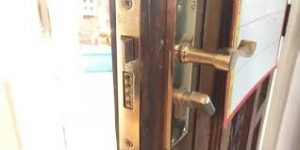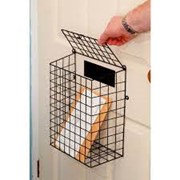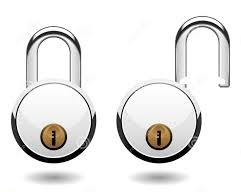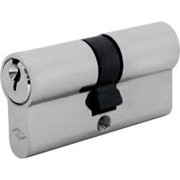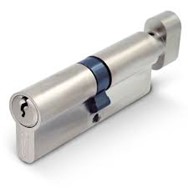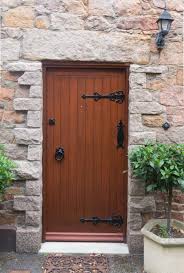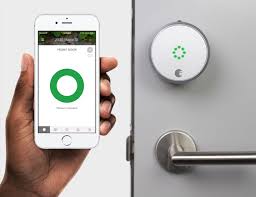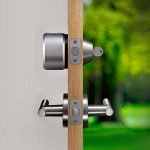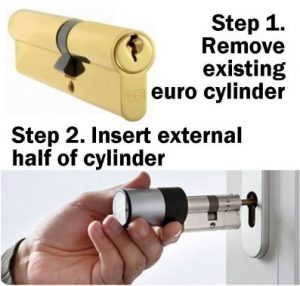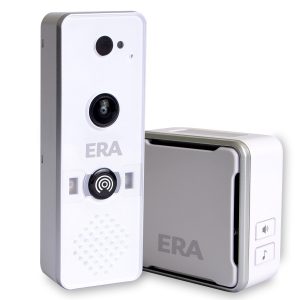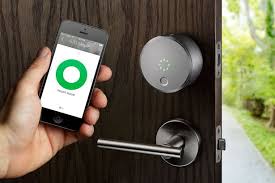With technology speeding us ever faster into the future, Smart locks are becoming more common. Lots of people want keyless entry or remote access.
There are lots of options available but if you don’t know exactly what you are looking for, you could be spending a lot of money on an open invitation to a burglar. If you look on shopping websites, you can find lots of these new Smart Locks, but very few of them show you the actual parts of your old lock that you need to keep or install. You might already have an insurance rated lock installed, but the modification to smart lock could reduce your security, giving your insurer an excuse not to pay up if the worst should happen. Some people have two locks on their doors. If you stop using one because the other one has been changed to a Smart Lock and you don’t want to carry keys anymore, then you have instantly halved your security on that door. So think hard about whether or not a Smart Lock is right for you and whether or not it is actually going to improve your experience of door entry. Don’t get me wrong – I’m not saying they are all bad. Some have some great features and I will do my best to cover the more popular ones here.
For those of you with multi-point locking mechanisms there are two main options. Multipoint locking mechanisms are the doors like upvc, composite, etc. where you have to lift the handles before you turn a key to lock and hooks/bolts/rollers form multiple locking points for the door.
The first option is a full handle kit which can be unlocked by smart phone app or a tag you can carry with you that will open the lock from about 2 metres proximity.
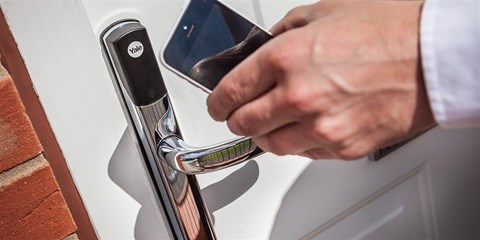
Or you can have a digilock with a pin code:
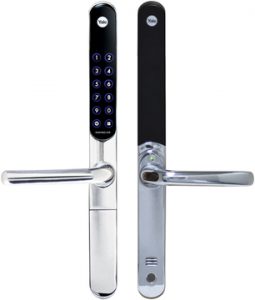
Or even a finger print scanner:
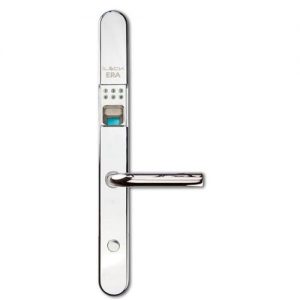
The other option on a multipoint door is just to change the cylinder for a smart one. Like this:
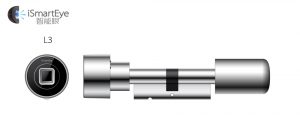
These can also be phone app controlled or used with proximity tags…if you like great big bulbous protrusions on your door.
The main problem with all of the above is that you still need to lift the handles before you lock the door, so the locking up when leaving is just as time consuming as if you were using a key, and with the handle smart locks, only certain types will fit certain brands, so they are far from universal.
So who are these good for? Well the good news is that on the day of writing this, multipoint locking doors do not need kite marked products to satisfy most insurers(although any good locksmith will strongly recommend that you do have BSI3621 kite marked locks). As long as the lock fits your door, you can have one and rest assured that your insurance will cover the worst case scenario. If you like to do everything via an app on your phone, then this is for you. Finger print technology is improving all the time, so if you worry about key and/or phone theft, then no one is likely to steal your finger print (unless you are a super-secret spy from some Hollywood film!). Do you have lots of things to carry from the car? Then something with a proximity tag can help, although you will still need a spare elbow to operate the handles.
My best use for these locks though, is for our elderly relatives. I see a lot of older customers who have poor eyesight, or shaky hands and they can have real problems getting keys into small holes. One of these locks with a proximity tag will help them keep independent for longer. Tags can also be worn around the neck meaning less chance of losing keys.
Smart phone operated locks can be used for restricted remote access as well. More on that later.
With wooden doors, there is a bit of a problem when it comes to Smart Locks. Here is where we need insurance rated locks. If you look at your insurance terms and conditions, somewhere it will require you to have a five lever mortice lock or BSI3621 equivalent or multipoint locking system. I have covered the multipoint locking system above, but will, just take a couple of minutes here to explain the other bits. A five lever mortice lock is one that sits inside a wooden (or metal) door and has a deadbolt that is operated by a key. Like this:
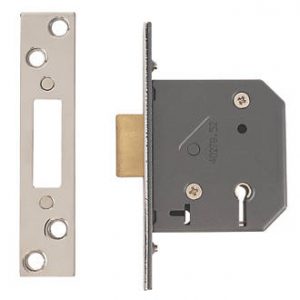
The levers are inside
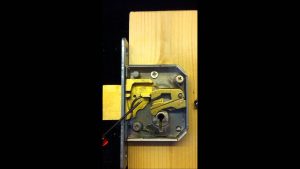
And those levers are put into the correct position by the key to allow the bolt to move forwards and back. Just as often, the lock also has a latch which is operated by handles or a knob. Having a one, two, or three lever mortice lock on your final exit door is not good enough for your insurance. It must be five as a minimum. Better still, a BSI 3621 kite marked mortice lock will have a longer bolt that is resistant to hacksaws, an anti-pick curtain that makes picking the lock a lot harder, and anti-drill plates that stop standard drill bits and make most hardened drill bits single use products. On a wooden door, this is your main point of security. And I cannot find any smart lock that works with these locks. You can get mortice lock cases that take euro cylinders and therefore can take the cylinder smart locks mentioned above for multipoint locking mechanisms, but that takes away your insurance rating so it’s only practical for internal doors.
So what smart locks can you get for wooden doors?
They come in two types. The first is the handle smart lock and it looks something like this:
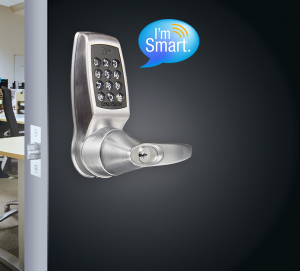
It can be operated by tag, pin code or even a key. But a lock is only as good as its’ weakest part and just look at the tiny latch this one has been fitted to. These should only really be fitted inside commercial properties where you want restricted access but you are not trying to protect £1000’s worth of equipment or sensitive data. Alternatively, somewhere like a care home with restricted access to certain areas. You would not want one of these on the front door to your house.
For domestic properties with wooden doors, we have the Smart lock for a nightlatch (often called a Yale type lock);
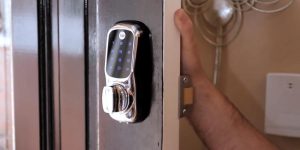
Again, you can have the proximity tags, code entry, phone app entry and some still have a standard key override, but an ordinary nightlatch does not meet your insurance requirements. Here are two examples of an ordinary nightlatch that you can attach one of these Smart locks to;
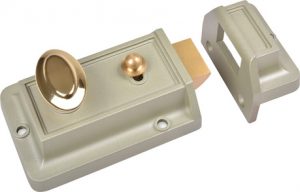
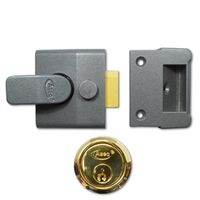
The nightlatch smart lock simply replaces the outer keyhole and keeps all of the internal parts. But if this is your only lock, then you are not insured. If you have a five lever mortice lock as well, but you don’t use the mortice lock because you only want to use the keyless smart lock, then you are still not insured.
This is a nightlatch that does meet insurance standards;
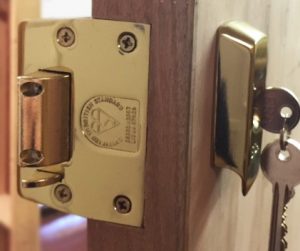
You can see it has the BSI3621 British Standard Kite mark. This lock auto-deadlocks when you shut the door, turning the latch into a bolt. The reinforced key housing is anti-drill and anti-pick. When I fit these locks, I tell my customer to not lose their keys because I really don’t want to be the one trying to break in for them. You can also lock the inside lever which means burglars know that even if they break in through a window, they can’t carry your possessions back out through your front door.
Now, you could put a nightlatch smart lock onto this and feel pretty secure, but as you are removing the anti-drill and anti-pick element that you get with the key housing, your insurance goes into a grey area and if that means the difference between an insurer paying and not paying, then you know what the most likely outcome will be. Now as a lock geek, I have my favourite locks, and the one pictured above is by far my favourite. It is made by a company called ERA and for a long time, I have wanted some sort of smart lock that would work with this nightlatch.
What I got, was something better. ERA are in the closing stages of making a British Standard Smart nightlatch that is a modification of the lock shown above. I can’t show you a picture yet because this is pre-launch, but I am told it will be available by summer 2018. And they have really thought about what the lock should do. It is phone app controlled, but whereas many app activated locks so far require you to get your phone out of your bag/pocket, switch the phone on, input your security code, search for the app, find the correct command within the app and finally use the app to unlock the door (a process that can take longer than just getting a key out and doing things the old way), this lock just requires that your phone is on your person and has power. Because it runs as a background app, you simply walk up to your door, push a small button (even with your nose if your hands are full!), and the latch retracts allowing you access to your property. If you go on holiday, you can give a neighbour a time limited access code on their mobile phone so they can feed your cat. Or you can give carers time limited codes to look after your elderly relatives.
Now, remember I spoke about restricted remote access.
Here is the really clever bit. Here are two more great items available from ERA.
First is the door intercom:

This device allows you to see and talk to anyone who rings the doorbell without even having to get out of your seat. It takes snap shots and even has night vision.
The second piece of great equipment from ERA is this home alarm kit;
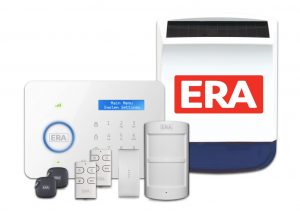
This basic kit can have the following added to it wirelessly:
Smoke alarms, Extra sensors, Cameras, Window contact sensors, Remote controls, Proximity tags
The anti-hack technology has been rigorously tested with a super high encryption level.
You can record messages to leave for your partner or the kids. It can dial a pre-stored number and you can talk to someone hands free. The remote controls have an SOS so if, for instance, your infirm relative takes a fall, they can press the SOS and you can talk to them instantly and find out how serious it is. And it will pair up with the new lock, the video intercom and smart hubs like the Echo devices.
This means you can now be on the beach in Spain and still receive a delivery. Your complete system will ring your phone when the delivery person arrives and you can see them through the intercom and even talk about the delivery. You can then use the same app to disarm your alarm and let the person, watching them with the wireless cameras as they put the package wherever you like in the house. You watch them go and know that the door is locked and then you re-arm your alarm system, knowing it will alert you to any unauthorised access recording in HD and allowing you to ring a friend who can get there immediately, while you use the intercom to tell the intruder they are seconds away from being caught red-handed.
If you have any questions regarding the above, please get in contact using any of the methods on my contacts page.
Thanks for reading.
Smart lock Holt, Smart Lock Sheringham, Smart lock Cromer, Smart lock Fakenham, Smart lock North Walsham, Smart Lock Norwich, Smart lock Norfolk, Smart Lock near me, Wireless alarm, Digital door viewer, Wireless intercom, Mortice lock, Nightlatch, Smart Lock Swaffham, Smart lock Dereham, Smart lock Burnham Market, Keyless entry, Finger print entry, Access control, Smart nightlatch

